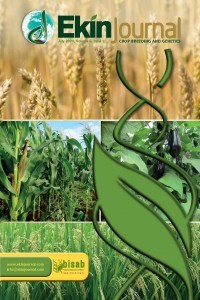Evaluation of Bread Wheat (Triticum aestivum L.) Genotypes for Yellow Rust Resistance in Relation to Meteorological Parameters
Evaluation of Bread Wheat (Triticum aestivum L.) Genotypes for Yellow Rust Resistance in Relation to Meteorological Parameters
Stripe rust, bread wheat Triticum aestivum L., temperature, rainfall, relative humidity,
___
- Ahmed S, Afzal LRN, Iqbal Z, Akhtar N, Iftkar Y and Kamran M, (2010). Prediction of yield losses in bread wheat (Triticum aestivum L.) caused by yellow rust in relation to epidemiological factors in Faisalabad. Pak. J. Bot., 42: 401-407.
- Akar T, Yazar S and Donmez E, (2007). Current status of national winter bread wheat breeding in Turkey. J. Agric. Res., 45: 1-9.
- Beddow JM, Pardey PG, Chai Y, Hurley TM, Kriticos DJ and Braun JC, (2015). Research investment implications of shifts in the global geography of bread wheat stripe rust. Nat. Plant, 1: 132.
- Chen W, Wellings C, Chen XM, Kang ZS and Liu TG, (2014). Bread wheat stripe (yellow) rust caused by Puccinia striiformis f. sp. tritici. Mol. Pl. Path., 15: 433-446.
- Chen XM, (2005). Epidemiology and control of stripe rust (Puccinia striiformis f. sp. tritici) on bread wheat. Can. J. Pl. Path., 27: 314-337.
- Chen WQ, Wu LR, Liu TG and Xu SC, (2009). Race dynamics, diversity and virulence evolution in Puccinia striiformis f. sp. tritici, the causal agent of bread wheat stripe rust in China from 2003 to 2007. Pl. Dis., 93: 1093-1101.
- Christensen K, Jorgensen LN and Secher BJM, (1993). Development of a yellow rust model based on historical data. In: Proceeding of the 10th Danish Plant Protection Conference on Plantevaernscentret, Lyngby, Denmark, pp. 71-78.
- Coakley SM, Line RF and McDaniel R, (1988). Predicting stripe rust on winter bread wheat using an improved method for analyzing meteorological and rust data. Phytopathol., 78: 543-550.
- Cornell JA and Berger RD, (1987). Factors that influence the value of co-efficient of determination in simple linear and nonlinear regression models. Phytopathol., 77: 63-70.
- Curtis BC, Rajaram S and Macpherson HG, (2002). Bread Wheat: Improvement and Production. Food and Agriculture Organization of the United Nations, Rome, Italy, Series Number 30, p.554.
- DeVallavielle-Pope C, Huber L, Leconte M and Bethenod O, (2002). Pre-inoculation effects of light quantity on infection efficiency of Puccinia striiformis and Puccinia triticina on bread wheat seedlings. Phytopathol., 92: 1308-1314.
- Hovmøller MS, (2016). Replacement of the European bread wheat yellow rust population by new races from the centre of diversity in the near-Himalayan region. Pl. Pathol., 65: 402-411.
- evtić R, Župunski V, Lalošević M and Župunski LJ, (2017). Predicting potential winter bread wheat yield losses caused by multiple disease systems and climatic conditions. Crop Prot., 99: 17-25.
- Jarroudi ME, (2017). A threshold-based weather model for predicting stripe rust infection in winter bread wheat. Pl. Dis., 101: 693-703.
- Line RF, (2002). Stripe rust of bread wheat and barley in North America: a retrospective historical review. Ann. Rev. Phytopathol., 40: 75-118.
- Madden LV, (1986). Statistical analysis and comparison of disease progress curve. In: Plant disease Epidemiology: Population Dynamic and Management (Eds. Loonard, K.J. and Fry, W.E.). Macmillan, New York (NY), pp. 55-83.
- Pandey P, Irulappan V, Bagavathiannan MV and Senthil- Kumar M, (2017). Impact of combined abiotic and biotic stresses on plant growth and avenues for crop improvement by exploiting physiomorphological traits. Front. Pl. Sci., 8: 537.
- Peterson RF, Campbell AB and Hannah AE, (1948). A diagrammatic scale for estimating rust intensity on leaves and stems of cereals. Can. J. Res., 26(5): 496-500.
- Singh RP, William HM, Huerta-Espino J and Rosewarne G, (2004). Bread wheat rust in Asia: meeting the challenges with old and new technologies. In: Proceedings of the 4th International Crop Science Congress, Brisbane, Australia.
- Singh RP, Huerta-Espino J, Bhavani S, Herrera- Foessel SA, Singh D, Singh PK, Velu G, Mason RE and Crossa J, (2002). Race non-specific resistance to rust diseases in international maize and bread wheat improvement centre, Mexico spring bread wheat. Euphytica., 179: 175-186.
- Singh TB and Tewari AN, (2001). The role of weather conditions in the development of foliar diseases of bread wheat under tarai conditions of north western India. Pl. Dis. Res., 16: 173-178.
- TeBeest DE, Paveley ND, Shaw MW, Pietravalle S and Vanden BF, (2009). Disease weather relationship for powdery mildew and yellow rust on winter bread wheat. Phytopathol., 124: 413-425.
- Wellings CR, (2011). Global status of stripe rust: a review of historical and current threats. Euphytica, 179: 129-141.
- Wellings CR, Singh RP, McIntosh RA and Yayhaoui A, (2000). The assessment and significance of pathogenic variability in Puccinia striiformis in breeding for resistance to stripe (yellow) rust. In: Proceeding of 11th Regional Bread wheat Workshop for Eastern, Central and Southern Africa, Addis Ababa, Ethiopia, Africa, pp. 18-22.
- ISSN: 2149-1275
- Yayın Aralığı: Yılda 2 Sayı
- Başlangıç: 2015
- Yayıncı: Bitki Islahçıları Alt Birliği
Registration of "Vehbibey" Durum Wheat (Triticum durum Desf.) Variety
Selami YAZAR, Bayram ÖZDEMİR, Emin DÖNMEZ, Ayten SALANTUR, Mehmet Emin ALYAMAÇ, Gökhan KILIÇ, Muhsin İbrahim AVCI, Fatma Betül SADE
Rajesh KUMAR ARYA, Ravi KUMAR, Jagbir SİNGH HOODA, Jhabar MAL SUTALIYA, Gajraj Singh DAHIYA, Vandana VANDANA, Hanuman Lal RAIGER, Satish Kumar YADAV, Ranjit Kaur GILL, Jay Lal MEHTO, Jitendra Kumar Tıwarı TIWARI, Chander Bhan Yadav YADAV, Md. Khabruddin DEEN, Rakesh PUNIA, Kushal RAJ, Roshan LAL, Pa
Ganesh Kumar KOL, Rajesh Kumar ARYA
Pooja POOJA, Satyavir Singh DHANDA, Virender Singh PAHIL, Rishi Kumar BEHL
Variety Development of Wheat in Turkey and the Impact of Regulations
Maggie CHAKHOLOMA, Somveer NIMBAL, Ashish Jaın JAIN, Manoj KUMAR
Registration of "Albaşak" Bread Wheat (Triticum aestivum L.) Variety
Adil NAIK, Shabir Hussain WANI, Sumira RAFIQEE, Mehrajuddin SOFI, Najeebul Rehman SOFI, Asif Bashir SHIKARI, Ashaq HUSSAIN, Fayaz MOHIDDIN, Intikhab Aalum JEHANGIR, Gazala Hassan KHAN, Muneer Ahmed SOFI, Farooq Ahmed SHEIKH, Mohammad Ashraf BHAT, Mohammad Nisar KHAN, Zahoor Ahmed DAR, Mehdi RAHIMI
Crossability Studies Among Various Species of Genus Vigna
Shailja SHARMA, Raj K. MITTAL, Vinod K. SOOD, Harinder K. CHAUDHARY
